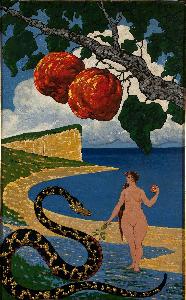Marian Wawrzeniecki
Marian Wawrzeniecki
Place: Warsaw
Born: 1863
Death: 1943
Biography:
Marian Wawrzeniecki was a renowned Polish archaeologist, painter, and art historian born on December 5, 1863, in Warsaw, Poland. He came from a family of Polish nobility and went on to study painting in Warsaw under Wojciech Gerson and later in Krakow under Jan Matejko. Wawrzeniecki's work is characterized by symbolic and mystical motifs, allegorical themes inspired by Slavic myths and legends.
Artistic Career and Influences
Wawrzeniecki's artistic style was influenced by his studies under Jan Matejko, a Polish painter known for his historical and patriotic themes. Wawrzeniecki's own work often featured allegorical themes and symbolic motifs, reflecting his interest in Slavic mythology and legends. His paintings can be found in various museums, including the National Museum in Warsaw and the Museum Pomorskie in Gdańsk.
Notable Works and Collections
Some of Wawrzeniecki's notable works include illustrations for magazines and books, as well as paintings that showcase his unique style. His work can be found in various collections, including the Museum Narodowe w Warszawie and the Muzeum Kolekcji Im. Jana Paw-a II in Warsaw. For more information on Wawrzeniecki's work, visit Marian Wawrzeniecki's page on Wikioo.org.
Legacy and Importance
Wawrzeniecki's legacy as a painter and art historian is significant, with his work providing valuable insights into Polish culture and history. His use of allegorical themes and symbolic motifs has influenced many other artists, and his paintings continue to be celebrated for their unique style and beauty. To learn more about Wawrzeniecki's life and work, visit the National Museum in Warsaw or explore his page on Wikioo.org.
- Visit the National Museum in Warsaw to see Wawrzeniecki's paintings in person.
- Explore Wawrzeniecki's page on Wikioo.org for more information on his life and work.
- Discover other Polish artists, such as Tomasz Ciecierski, on Wikioo.org.
Wawrzeniecki's contributions to Polish art and culture are immeasurable, and his legacy continues to inspire artists and historians today. Through his unique style and use of allegorical themes, Wawrzeniecki has left a lasting impact on the world of art.

